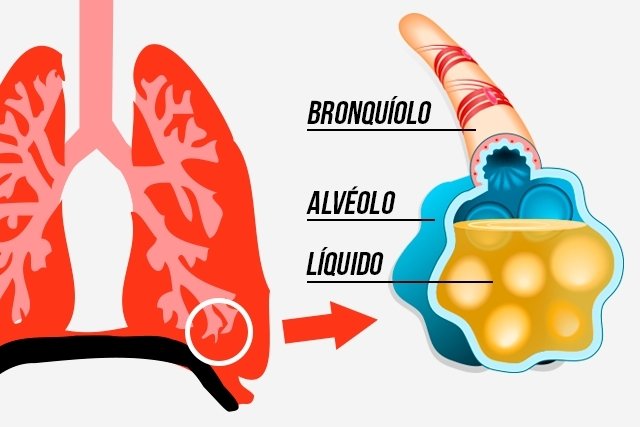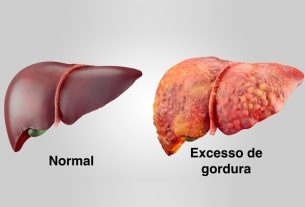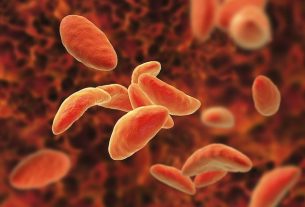Water in the lung is when the lung alveoli become filled with fluid, usually due to other untreated illnesses, such as heart failure or respiratory infections, for example.
Known scientifically as pulmonary edema, the presence of water in the lungs makes breathing very difficult and reduces the intake of oxygen into the body, causing a sensation of shortness of breath, wheezing and intense coughing.
There is a cure for water in the lungs, however, treatment must be started as quickly as possible to prevent oxygen levels in the body from dropping too low and putting life at risk. Understand how lung water is treated.

Symptoms of water in the lung
The main symptoms of water in the lung are:
- Difficulty breathing, which worsens when lying down;
- Feeling of suffocation or drowning;
- Intense wheezing when breathing;
- Cough with secretion that may contain blood;
- Intense chest pain;
- Tired very easily;
- Swelling of the legs or feet.
When more than one of these symptoms appears, it is advisable to call for medical help by calling 192, or go immediately to a hospital emergency room to take a chest X-ray, confirm the diagnosis and quickly begin treatment.
Is water in the lungs serious?
Water in the lungs can put a person’s life at risk if not identified and treated quickly, especially when symptoms appear suddenly. When there is pulmonary edema, the exchange of gases in the lungs does not occur efficiently, reducing the body’s oxygen levels, which can lead to death.
How to confirm the diagnosis
In most cases, to confirm the diagnosis of pulmonary edema, the doctor analyzes the signs and symptoms, as well as the history of previous illnesses, such as hypertension, diabetes or heart attack. The physical examination is extremely important to reach a diagnosis, and during this examination the doctor must listen to the chest, look for swelling in the legs and assess blood pressure.
In addition, it may also be necessary to undergo an X-ray, electrocardiogram or echocardiography to determine the cause of the water in the lungs.
Causes of water in the lung
The most common cases of water in the lungs occur when there is a cardiovascular disease, such as coronary disease, heart failure or high blood pressure, as the heart can stop working properly, causing an accumulation of blood in the lungs and making it difficult for air to enter.
However, there are other situations that can cause the accumulation of liquids, such as:
- Adult respiratory distress syndrome;
- Climb to altitudes above 2400 meters, like climbing a mountain;
- Nervous system problems such as head trauma, subarachnoid hemorrhage or seizure;
- Infections caused by viruses in the lungs;
- Smoke inhalation;
- Almost drowning, especially when water was inhaled.
The problem of water in the lungs is more common in the elderly, as they present more health changes, but it can also happen in young people or even in children with congenital heart defects. Learn more about the causes of water in the lungs.
How the treatment is carried out
Treatment for water in the lungs must be carried out while admitted to the hospital and is normally started with the administration of oxygen through a mask to alleviate symptoms such as difficulty breathing, a feeling of drowning and wheezing. Additionally, some remedies can be used to eliminate excess fluid, such as:
- Diuretic medicinessuch as furosemide: help eliminate excess fluids from the body through urine;
- Heart remediessuch as nitroglycerin: relieves pressure on the heart arteries, improving their functioning and preventing the accumulation of blood in the lungs;
- Morphine: is used to relieve the feeling of intense shortness of breath or severe chest pain;
- High blood pressure medicinesquick-response, such as nitroglycerin: reduce blood pressure, facilitating the work of the heart and preventing the accumulation of fluids.
Due to the effect of medications to eliminate excess fluid, the doctor may recommend using a bladder catheter to quantify the amount of urine being eliminated after using the diuretic. See how to properly care for your bladder catheter to avoid infections.
When treatment for water in the lungs is not carried out, some signs of worsening may appear, including worsening of symptoms, such as the feeling of drowning, purple extremities, fainting and, in the most serious cases, respiratory arrest.
Bibliography
- KASPER, Dennis et al.. Harrison Principles of Internal Medicine. 16.ed. México D.F: Mc Graw-Hill, 2006. 1784-1786.
- BAIRD, Andrew. Acute pulmonary oedema. Australian Family Physician. Vol.39. 12.ed; 910-914, 2010
- BROADDUS, V. Courtney. et al. Murray & Nadel treatise on respiratory medicine. 6.ed. Rio de Janeiro: Elsevier, 2017. p. 1081-1117.

Sign up for our newsletter and stay up to date with exclusive news
that can transform your routine!
Warning: Undefined array key "title" in /home/storelat/public_html/wp-content/plugins/link-whisper-premium/templates/frontend/related-posts.php on line 12
Warning: Undefined array key "title_tag" in /home/storelat/public_html/wp-content/plugins/link-whisper-premium/templates/frontend/related-posts.php on line 13



